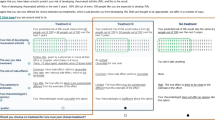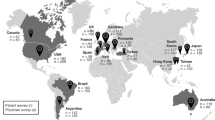Abstract
The objectives of the study were to determine the relative importance of barriers related to the provision of intensive combination treatment strategies with glucocorticoids (ICTS-GCs) in early rheumatoid arthritis (ERA) from the rheumatologists’ perspective and to explore the relation between rheumatologists’ characteristics and importance scores. A maximum difference scaling (MDS) survey was administered to 66 rheumatologists in Flanders and the Brussels-Capital Region. The survey included 25 barriers, previously being discovered in a qualitative study. The survey included 25 choice sets, each of which contained a different set of four barriers. In each choice situation, respondents were asked to choose the most important barrier. The mean relative importance score (RIS) for each barrier was calculated using hierarchical Bayes modeling. The potential relation between rheumatologists’ characteristics and the RIS was examined using Spearman’s correlation coefficient, Mann-Whitney U test, and Kruskal-Wallis H test. The three highest ranked barriers included “contraindicated for some patients (e.g., patients with comorbidities, older patients),” “an increased risk of side effects and related complications,” and “patients’ resistance” with a mean ± SD RIS of 9.76 ± 0.82, 8.50 ± 1.17, and 7.45 ± 1.22, respectively. Comparing the RISs based on rheumatologists’ characteristics, a different ranking was found for three barriers depending on the age, university location, and/or frequency of prescribing ICTS-GCs. The dominant barriers hindering ICTS-GCs prescription from a rheumatologists’ perspective are patient-related barriers and barriers related to the complexity of prescribing a combination therapy including GCs. A tailored improvement intervention is needed to overcome these barriers and should focus on the familiarity of rheumatologists with ICTS-GC and patient education.





Similar content being viewed by others
References
National Institute for Health and Clinical Excellence (2009) The management of rheumatoid arthritis in adults (clinical guideline 79). London: NICE. http://www.nice.org.uk/CG79 Accessed 14 October 2014
Smolen J, Landewé R, Breedveld F, Buch M, Burmester G, Dougados M et al. (2013) EULAR recommendations for the management of rheumatoid arthritis with synthetic and biological disease-modifying antirheumatic drugs: 2013 update. Ann Rheum Dis 73:492–509
Singh JA, Furst DE, Bharat A, Curtis JR, Kavanaugh AF, Kremer JM et al (2012) 2012 update of the 2008 American College of Rheumatology recommendations for the use of disease‐modifying antirheumatic drugs and biologic agents in the treatment of rheumatoid arthritis. Arthritis Care Res 64:625–639
Verhoeven A, Bibo J, Boers M, Engel G, Van Der Linden S (1998) Cost-effectiveness and cost-utility of combination therapy in early rheumatoid arthritis: randomized comparison of combined step-down prednisolone, methotrexate and sulphasalazine with sulphasalazine alone. COBRA Trial Group. Combinatietherapie Bij Reumatoïde Artritis. Rheumatology 37:1102–1109
Verschueren P, Esselens G, Westhovens R (2008) Daily practice effectiveness of a step-down treatment in comparison with a tight step-up for early rheumatoid arthritis. Rheumatology 47:59–64
Goekoop‐Ruiterman Y, De Vries‐Bouwstra J, Allaart C, Van Zeben D, Kerstens P, Hazes J et al (2005) Clinical and radiographic outcomes of four different treatment strategies in patients with early rheumatoid arthritis (the BeSt study): a randomized, controlled trial. Arthritis Rheum 52:3381–3390
De Cock D, Vanderschueren G, Meyfroidt S, Joly J, Westhovens R, Verschueren P (2014) Two-year clinical and radiologic follow-up of early RA patients treated with initial step up monotherapy or initial step down therapy with glucocorticoids, followed by a tight control approach: lessons from a cohort study in daily practice. Clin Rheumatol 33:125–130
Verschueren P, Westhovens R (2011) Optimal care for early RA patients: the challenge of translating scientific data into clinical practice. Rheumatology 50:1194–1200
Garrood T, Shattles W, Scott DL (2011) Treating early rheumatoid arthritis intensively: current UK practice does not reflect guidelines. Clin Rheumatol 30:103–106
Kiely P, Walsh D, Williams R, Young A (2011) Outcome in rheumatoid arthritis patients with continued conventional therapy for moderate disease activity—the early RA network (ERAN). Rheumatology 50:926–931
Esselens G, Westhovens R, Verschueren P (2009) Effectiveness of an integrated outpatient care programme compared with present‐day standard care in early rheumatoid arthritis. Musculoskelet Care 7:1–16
Benhamou M, Rincheval N, Roy C, Foltz V, Rozenberg S, Sibilia J et al (2009) The gap between practice and guidelines in the choice of first-line disease modifying antirheumatic drug in early rheumatoid arthritis: results from the ESPOIR cohort. J Rheumatol 36:934–942
Maio GR, Verplanken B, Manstead AS, Stroebe W, Abraham C, Sheeran P et al (2007) Social psychological factors in lifestyle change and their relevance to policy. Soc Issues Policy Rev 1:99–137
Grol R, Grimshaw J (2003) From best evidence to best practice: effective implementation of change in patients’ care. Lancet 362:1225–1230
Baker R, Camosso-Stefinovic J, Gillies C, Shaw EJ, Cheater F, Flottorp S et al (2010) Tailored interventions to overcome identified barriers to change: effects on professional practice and health care outcomes. Cochrane Database Syst Rev 3:CD005470
Grimshaw JM, Thomas RE, MacLennan G, Fraser C, Ramsay CR, Vale L et al (2004) Effectiveness and efficiency of guideline dissemination and implementation strategies. Health Technol Assess 8:1–72
Bosch M, Van Der Weijden T, Wensing M, Grol R (2007) Tailoring quality improvement interventions to identified barriers: a multiple case analysis. J Eval Clin Pract 13:161–168
van Tuyl LH, Plass AM, Lems WF, Voskuyl AE, Kerstens PJ, Dijkmans BA et al (2008) Discordant perspectives of rheumatologists and patients on COBRA combination therapy in rheumatoid arthritis. Rheumatology 47:1571–1576
Meyfroidt S, van Hulst L, De Cock D, Van der Elst K, Joly J, Westhovens R et al (2014) Factors influencing the prescription of intensive combination treatment strategies for early rheumatoid arthritis. Scand J Rheumatol 43:265–272
Pope JE, Hong P, Koehler BE (2002) Prescribing trends in disease modifying antirheumatic drugs for rheumatoid arthritis: a survey of practicing Canadian rheumatologists. J Rheumatol 29:255–260
Criswell L, Henke C (1995) What explains the variation among rheumatologists in their use of prednisone and second line agents for the treatment of rheumatoid arthritis? J Rheumatol 22:829–835
Verschueren P, De Cock D, Corluy L, Joos R, Langenaken C, Taelman V et al (2015) Methotrexate in combination with other DMARDs is not superior to methotrexate alone for remission induction with moderate to high dose glucocorticoid bridging in early rheumatoid arthritis after 16 weeks of treatment: the CareRA trial. Ann Rheum Dis 74:27–34
Orme B (2006) Maxdiff analysis: simple counting, individual-level logit, and hb. Sawtooth Software technical paper series. http://www.sawtoothsoftware.com/download/techpap/indivmaxdiff.pdf Accessed 14 October 2014
Johnson RM (2000) Understanding HB: an intuitive approach. Sawtooth Software. https://sawtoothsoftware.com/download/techpap/undhb.pdf Accessed 14 October 2014
Markenson M, CCMEP C, Dietze M, CCMEP D (2013) US rheumatologists’ attitudes, practice habits, barriers and knowledge gaps in assessing and monitoring patients with rheumatoid arthritis according to recent recommendations. CE Measure 7:87–95
Sheeran P (2002) Intention—behavior relations: a conceptual and empirical review. Eur Rev Soc Psychol 12:1–36
Cabana MD, Rand CS, Powe NR, Wu AW, Wilson MH, Abboud PAC et al (1999) Why don’t physicians follow clinical practice guidelines? JAMA 282:1458–1465
Shaw B, Cheater F, Baker R, Gillies C, Hearnshaw H, Flottorp S et al (2005) Tailored interventions to overcome identified barriers to change: effects on professional practice and health care outcomes. Cochrane Database Syst Rev 3:CD005470
Yano EM (2008) The role of organizational research in implementing evidence-based practice: QUERI Series. Implement Sci 3:29
Wensing M, Elwyn G (2003) Improving the quality of health care: methods for incorporating patients’ views in health care. BMJ 326:877
Wensing M, Elwyn G (2002) Research on patients’ views in the evaluation and improvement of quality of care. Qual Saf Health Care 11:153–7
Meyfroidt S, Van der Elst K, De Cock D, Joly J, Westhovens R, Hulscher M et al (2015) Patient experiences with intensive combination-treatment strategies with glucocorticoids for early rheumatoidarthritis. Patient Educ Couns 98:384–390
Acknowledgments
The authors would like to thank all rheumatologists who participated.
Conflict of interest
None.
Author information
Authors and Affiliations
Corresponding author
Rights and permissions
About this article
Cite this article
Meyfroidt, S., Hulscher, M., De Cock, D. et al. A maximum difference scaling survey of barriers to intensive combination treatment strategies with glucocorticoids in early rheumatoid arthritis. Clin Rheumatol 34, 861–869 (2015). https://doi.org/10.1007/s10067-015-2876-3
Received:
Revised:
Accepted:
Published:
Issue Date:
DOI: https://doi.org/10.1007/s10067-015-2876-3




